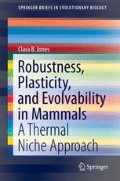Abstract
Any change in consumer–user interactions may have positive, negative, or neutral effects on relative reproduction of consumers and mean fitness of populations. At all levels of organization, individuals are characterized by “core” patterns, processes, and units (switches, circuits, protein regulation, neurotransmitter substances, motor patterns, recruitment), each of which is differentially responsive to abiotic and biotic (including social) stress. Some taxa appear to be preadapted to heterogeneous, even, near-lethal conditions (folivores), exhibiting significant thermal tolerances and resistance to thermal stress (desiccation). Flexibility as well as integration of system units is regulated by communication (“crosstalk”) and regulatory feedback between thermosensors, mitochondria, and transcription factors demonstrating “remarkable versatility” for many types of (robust and plastic) reorganization at the molecular level. Gene regulation is amenable to epigenetic effects, particularly ecological (microclimate) factors (variations in T, food), information that is stored in neural “memory,” influencing future molecular and cellular, including synaptic (“Hebbian”), events. Relative to system properties and tolerances, as well as spatiotemporal variations in limiting (functional ecological) resources (food items, nutrients, mates, breeding, conspecifics), energy is allocated to maintenance activities (system repair, homeostasis), survival (responses to parasitism, predation, interference, stress), and reproduction. At a given time, size of energy stores is limited (“elastic limit”) and limiting, but, in mammals, female thermal stores (“fat”) are proportionately larger compared to males in the same population. Some mammalian orders (rodents, bats, primates) include a number of species capable of storing energy in food pouches, and it may be of note that these orders include, as well, many social species. Several researchers highlight the paucity of field data on mammalian norms of reaction across ecological gradients, pointing out that, although much is known about separate stages from mammal genotypes to phenotypes, little is known about how the stages are coordinated and controlled from one level of system organization to another.
Access this chapter
Tax calculation will be finalised at checkout
Purchases are for personal use only
References
Cambridge SB, Gnad F, Nguyen C, Bermejo JL, Krüger M, Mann M (2011) Systems-wide proteomic analysis in mammalian cells reveals conserved, functional protein turnover. J Proteome Res. doi:dx.doi.org/10.1021/pr101183k
Eisenberg JF (1981) The mammalian radiations: an analysis of trends in evolution, adaptation, and behavior. University of Chicago Press, Chicago
Emlen ST, Oring LW (1977) Ecology, sexual selection, and the evolution of mating systems. Science 197:215–223
Haley SL, Lamb JG, Franklin MR, Constance JE, Dearing MD (2007) Xenobiotic metabolism of plant secondary compounds in juniper (Juniperus monosperma) by specialist and generalist wood rat herbivores, Genus Neotoma. Comp Biochem Physiol C 146:552–560
Hamilton WD (1964) The evolution of social behavior. J Theor Biol 7:1–52
Heidel AJ, Lawal HM, Felder M et al (2011) Phylogeny-wide analysis of social amoeba genomes highlights ancient origins for complex intercellular communication. Genome Res 21:1882–1891
Jones CB (1980) The functions of status in the mantled howler monkey (Alouatta palliate Gray): intraspecific competition for group membership in a folivorous Neotropical primate. Primates 21:389–405
Jones CB (2005a) Behavioral flexibility in primates: causes and consequences. Springer, New York
Jones CB (2005b) Phenotype as developmental bridge: whither nature and nurture? Am J Psychol 118:141–158, book review of West-Eberhard 2003
Jones CB (2005c) Social parasitism in mammals with particular reference to neotropical primates. Mastozoología Neotropical 12:19–35
Kirschner M, Gerhart J (1998) Evolvability. Proc Natl Acad Sci 95:8420–8427
Kitazoe Y, Kishino H, Hasegawa M, Matsui A, Land N, Tanaka M (2011) Stability of mitochondrial membrane proteins in terrestrial vertebrates predicts aerobic capacity and longevity. Genome Biol Evol 3:1233–1244
Krause EG, de Kloet AD, Flak JN, Smeltzer MD, Solomon MB, Evanson NK, Woods SC, Sakai RR, Herman JP (2011) Hydration state controls stress responsiveness and social behavior. Neuroscience 31:5470–5476
Mayr E (1976) Evolution and the diversity of life. Harvard University Press, Cambridge
Nijhout HF (2003a) Development and evolution of adaptive polyphenisms. Evol Dev 5:9–18
Nijhout HF (2003b) The control of growth. Development 130:5863–5867
Rutherford SL (2000) From genotype to phenotype: buffering mechanisms and the storage of genetic information. BioEssays 22:1095–1105
West SA, Pen I, Griffin AS (2002) Cooperation and competition between relatives. Science 296:72–75
Wheeler WM (1928) Insect societies: their origins and evolution. Harcourt Brace, New York
Wilson EO (1971) The insect societies. Cambridge, Belknap
Woodard SH, Fischman BJ, Venkat A, Hudson ME, Varala K, Cameron SA, Clark AG, Robinson GE (2011) Genes involved in convergent evolution of eusociality in bees. Proc Natl Acad Sci USA. http://www.pnas.org/cgi/doi.1073/pnas.1103457108
Wright S (1949) Adaptation and selection. In: Jepsin GC, Mayr E, Simpson GG (eds) Genetics, paleontology, and evolution. Princeton University Press, Princeton
Author information
Authors and Affiliations
Rights and permissions
Copyright information
© 2012 Clara B. Jones
About this chapter
Cite this chapter
Jones, C.B. (2012). Synopsis. In: Robustness, Plasticity, and Evolvability in Mammals. SpringerBriefs in Evolutionary Biology. Springer, New York, NY. https://doi.org/10.1007/978-1-4614-3885-4_7
Download citation
DOI: https://doi.org/10.1007/978-1-4614-3885-4_7
Published:
Publisher Name: Springer, New York, NY
Print ISBN: 978-1-4614-3884-7
Online ISBN: 978-1-4614-3885-4
eBook Packages: Biomedical and Life SciencesBiomedical and Life Sciences (R0)

